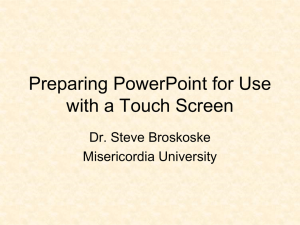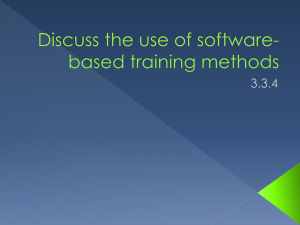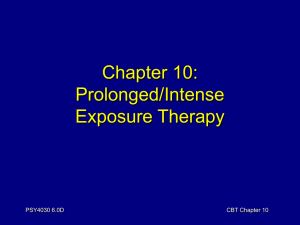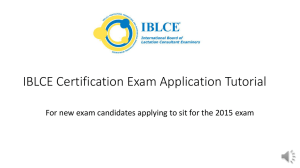Combining/Integrating MI and CBT
advertisement
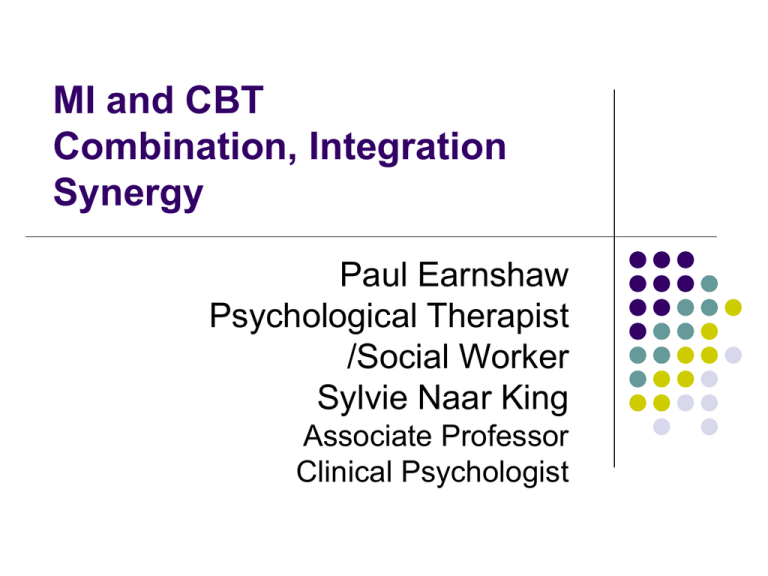
MI and CBT Combination, Integration Synergy Paul Earnshaw Psychological Therapist /Social Worker Sylvie Naar King Associate Professor Clinical Psychologist Explore combination Integration Synergy in MI CBT Use an extract from training developed with Rory Allott-thanks. MI enhances CBT nearly all MINTIES agree No definitive research to back that up My clinical experience in a Beckian CT world and in MIDAS trial - MICBT integration suggests that is does. We are more interested in what you think Combining/Integrating MI and CBT; Some Questions Why integrate? What are similarities and differences between MI and CBT? How to integrate (prelude, combination, integration)? Why bother? Is there a synergistic effect? What are the challenges presented to therapist, clients, and trainer around integration? Other questions? CBT & MI: What separates them and brings them together? Take the cards in front of you and distribute them around your group Elect three people to collect the cards One person collects cards that apply to MI and CBT One person collects cards that apply more to MI One person collects cards that apply more to CBT Elect a fourth person to guide the conversation Consider each card and discuss the placement Obviously, there are no right or wrong answers or expectations about the size of piles We will give you 20 mins Move about Place your cards on the continuum on the wall All cards will go on the wall so we can discuss consensus While you are doing this notice where the cards are going Debrief What themes emerged from your group’s discussion What were the challenges of this activity Combining/Integrating MI and CBT; Some Questions Why integrate? What are similarities and differences between MI and CBT? How to integrate (prelude, combination, integration)? Why bother? Is there a synergistic effect? What are the challenges presented to therapist, clients, and trainer around integration? MI and CBT “ sort of like cousins ” Peter Prescott “some kinds of Cognitive therapy look a lot like MI” List serve discussions. But what is different? Origins Many ‘kinds’ of cognitive behaviour therapy Beckian, Padesky, Metacognitive, REBT, CBT for substance use, DBT, ACT, Schema focussed, Compassionate Mind CBT, Method of Levels Makes comparisons difficult Only one Motivational Interviewing Miller and Rollnick Though many variations: MET, DDMI, AMI’s, Compliance therapy ? What other differences? Traditional Cognitive-Behavioral Therapy Motivational Interviewing Problem Focused Strengths Focused Formulation led Target-behaviour led Schema Values Expert-led Expert-trap How? Why? Thoughts-Feelings-Behaviour Values-Dissonance-Behaviour Change as a function of the individual Change as a function of the relationship Psychological-Medical Humanistic- Psychological But what is similar? Origins Neither grounded in theory Emerged from detailed phenomenological research Beck: Dreams Miller: Client utterances and values Cognitive-Behavioural journals Strong evidence-base and culture of evaluation What else is similar? Cognitive-behaviour Therapy & Motivational Interviewing Collaborative, Directive Empathic, Positive Regard Guided Discovery, Evocative Summaries, Questions, Reframe Self-monitoring, Relapse prevention, Normalising What to integrate from CBT? Agendas Formulation / Case conceptualisation Identifying Beliefs Problem solving Behavioural experiments Skills training Emphasis on self-monitoring What to integrate from MI? Listening for & responding to readiness to change Identifying core values Working with ambivalence Developing discrepancy Autonomy – client as agent of change NOT the therapy Supporting self-efficacy Reflective listening Affirmation How to integrate? Combination approaches MI as a prelude to CBT (Arkowitz et al 2008) Switching to MI during CBT to explore specific issues around ambivalence Integrative approaches Seamless joining together of CBT and MI “assimilative integration”an ‘Integrative Framework’ Stages of Readiness & Therapy Style Style of Therapy l na io g at i n iv w ot vie M ter In e l tiv ra ni i ou og v C ha apy Be er Th Client’s Stage of Change Precontemplation Contemplation Determination Action Maintenance Relapse Training issues Is it easier to train a CBT therapist to do MI or an MI therapist to do CBT? Why If you could teach both to a naïve counselor, would you do it sequentially or simultaneously. How would you integrate MI and CBT training In research trials use an MICT fidelity scale? Other Challenges CBT not necessary to be in the Spirit of MI Irrational thinking that needs to be corrected MI can result in a cognitive shift is this CBT CBT experts don’t see the need to integrate MI CBT models tend to be expert not client led Switching from one to the other is confusing


